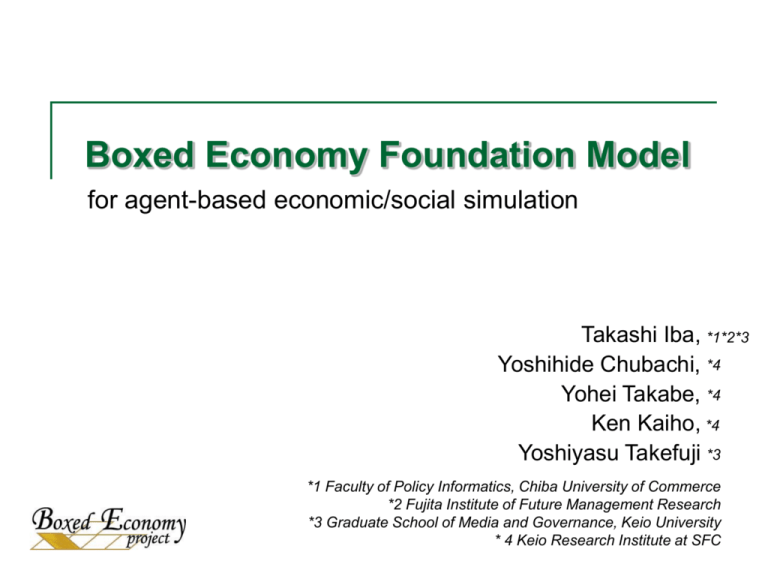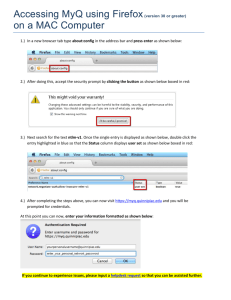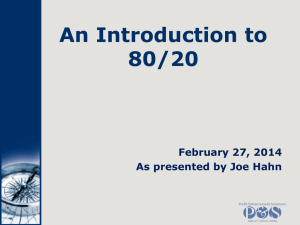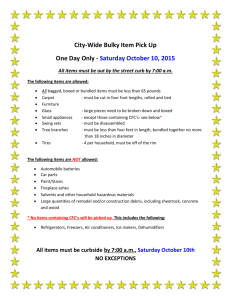Presentation (PPT: 6867 KB for MS PowerPoint XP)
advertisement

Boxed Economy Foundation Model
for agent-based economic/social simulation
Takashi Iba, *1*2*3
Yoshihide Chubachi, *4
Yohei Takabe, *4
Ken Kaiho, *4
Yoshiyasu Takefuji *3
*1 Faculty of Policy Informatics, Chiba University of Commerce
*2 Fujita Institute of Future Management Research
*3 Graduate School of Media and Governance, Keio University
* 4 Keio Research Institute at SFC
The gap
society as
interaction
social
sciences
decision making
and Learning
a new approach
of modeling
and analysis
“Agent-Based
Economic/Social
Modeling
and Simulation”
a practical
application
multi-agent
system
computer
science
computer
simulation
The area of agent-based economic/social modeling
and simulation has two natures
These two areas had been trying two merge, but they
are not enough confluent yet.
The gap
society as
interaction
social
sciences
decision making
and Learning
a new approach
of modeling
and analysis
“Agent-Based
Economic/Social
Modeling
and Simulation”
a practical
application
multi-agent
system
computer
science
computer
simulation
We need the well-defined primitive terms and
framework to describe the society by agentbased approach.
The gap
society as
interaction
social
sciences
decision making
and Learning
a new approach
of modeling
and analysis
“Agent-Based
Economic/Social
Modeling
and Simulation”
a practical
application
multi-agent
system
computer
science
computer
simulation
We need the system to implement and manage
the complex and dynamic social simulations efficiently.
The gap
society as
interaction
social
sciences
decision making
and Learning
a new approach
of modeling
and analysis
“Agent-Based
Economic/Social
Modeling
and Simulation”
a practical
application
multi-agent
system
computer
science
computer
simulation
Boxed Economy Project
society as
interaction
social
sciences
decision making
and Learning
a new approach
of modeling
and analysis
a practical
application
“Agent-Based
Economic/Social
Modeling
and Simulation”
Model framework
Simulation Platform
multi-agent
system
computer
science
computer
simulation
Boxed Economy Project
Introduction Video !
Agenda
1
Boxed Economy Foundation Model
2
Understanding BEFM with an Example
3
BEFM to Simulation Platform
4
The Road Ahead
Agenda
1
Boxed Economy Foundation Model
2
Understanding BEFM with an Example
3
BEFM to Simulation Platform
4
The Road Ahead
Main Class Diagram of
Boxed Economy Foundation Model
a model framework which has a tight focus to human economy/society.
Main Class Diagram of
Boxed Economy Foundation Model
Let’s run through some details of
Boxed Economy Foundation Model !
World and Entity
World is defined as an environment in which Entity are placed. Note that
the classes defined as Entity are Agent, Goods, Information, Behavior
and Needs. Only one instance of World would be created in each
simulation model.
Clock
Clock is defined as the class to manage the flow of time in the model,
during the execution of the simulation. Agent acts by the passage of
the time of Clock. Each model, actually each instance of World,
holds only one instance of Clock. In BEFM, it is not defined how to
implement the model of time yet. Therefore, the model builder will
determine in which form time would be implemented such as “year/
month/day/hour/minute/second” or discrete integer.
TimeOfDay is defined to describe a point of time in the model. Clock
holds the instance of TimeOfDay as a present time. Time is defined
as the difference between two points of TimeOfDay. We can also
calculate TimeOfDay by adding Time to TimeOfDay or subtracting
Time from TimeOfDay.
Location
Location is the class to describe a spatial position in the model. The spatial
position of Agents and Goods would be described with using Location,
and their migration and transportation can be described by changing the
values of Location. In BEFM, a concrete implementation of Location is not
defined yet. Therefore the model builder makes a choice of implementation,
such as two-dimensional lattice space, three-dimensional Euclidean space,
or even implementing no space in the model at all.
Direction and Distance are the classes which shows the relationship of
two points of Location. In addition, Region is defined to be composed of
two or more Locations, and Area is defined as the spatial size of Region.
Goods
Goods can be defined as material / unmaterial
thing which is possessed by Agent in order to
use by himself/herself, or to exchange with other
agents. For instance, the objects modeled as
Goods can be automobile, oil, corn, financial
stock, right of land, books, advertisings, diaries,
memorandum, water, voice, noises, garbage,
money, and so on.
Goods can be specified by the kind, the quality, and the amount by using GoodsKind,
GoodsQuality, and GoodsQuantity. Goods have Location in order to describe
where it is. In addition, Goods often holds Information describing various contents.
For instance, a newspaper can be modeled as an object that the newspaper article (as
Information) is printed on a paper (as Goods), and a conversation can be modeled
as an object which contents (as Information) is conveyed on the voice (as unmaterial
and transient Goods).
Information
The Information which accompanied by Goods and stored in the Agent are
defined as Information. Information will never exist alone, and be always held by
Goods or InformationManager of Agent. Information held in
InformationManager is the information stored in the Agent internally, for example
it can be described as ``memory'' and ``genetic information'' in the real world.
Information holds InformationContents which can be copied. The classes which
would be defined as InformationContets are RelationInformationContents,
ChannelInformationContents, NeedsInformationContents,
GoodsInformationContents, BehaviorInformationContents, GoodsQuantity,
GoodsKind, GoodsQuality, Location, NeedsStateDifference, Time, and
TimeOfDay.
Agent
Agent is defined to describe an
autonomous actor who does the
economic activity. Each individuals
and social groups such as
corporation, government, family,
school, regional community, and
country are all dealt as an Agent in
the model. In the model, Agent
exists as a more specific class:
Individual or SocialGroup.
Individual and SocialGroup inherit
all the characteristics of Agent.
Agent possesses more than one Behavior, Information, Relation, and Goods. Agent
holds and manages them by each manager: BehaviorManager, InformationManager,
RelationManager and GoodsManager. In addition, only Individual possesses Needs,
and manages it by NeedsManager.
Behavior
The behavior of the agent is defined as Behavior. Various activities such
as decision-making, production, trade and communication, are described
by Behavior of Agent. Two or more Behavior can be managed in parallel
inside an Agent. In BEFM, the internal state is given to each behavior, and
the internal state is dynamically changed respectively. Behavior is defined
as a state machine, which is a system that changes the state when the
event is received. Behavior holds more than one instance of
BehaviorState, and a present state as currentState.
State Transition of Behavior
and Some kinds of Events
Example: statechart diagram of SendRequestBehavior
state
transition
event
(trigger)
action
Behavior changes the state by receiving an event which means the stimulus from
outside. There are three kind of Event in BEFM: ChannelEvent, ClockEvent, and
NeedsEvent. ChannelEvent is an event sent from Channel. It holds Goods and
delivers them to the listener behavior. NeedsEvent is an event sent when Needs
becomes to a certain state. ClockEvent is an event sent when time passes on Clock.
It holds TimeOfDay and delivers it to the listener. Each Event is sent from the object
implemented the EventDispacher to the object implemented the EventListener.
Needs
Needs is hold only by Individual, and activates the Behavior of the
Individual. Needs holds two or more NeedsStates. The needs holds
the state which becomes a target as targetNeedsState and the state
which becomes a present state as currentNeedsState. The difference in
two states is NeedsStateDifference, which represents the strength of
Needs. Needs is able to is patch NeedsEvent to Behavior if necessary.
Needs is a model element which moves dynamically by the time
passage (reception of ClockEvent).
Relation
An agent in a model usually has
some kind of relationship with other
agents rather than being isolated. In
BEFM, the situation of a fact that a
certain agent knows other agents
will be described by Relation. By
using Relation, for example, friends,
family and employment can be
described.
Relation is an object by which two
Agents are connected with the
direction. Relation is managed by
Agent through RelationManager.
Channel
When an agent communicates with others, Channel
will be established between the Behaviors of the
agents based on Relation. Note that Channel does
not connect between Agents but connects between
Behaviors.
All communications between Behaviors will be abstracted as a deal of Goods through
Channel. First, Channel is used to exchange Goods, such as commodities, contents
of the conversation, and money, between Behaviors of Agents. Secondly, the
cooperation of Behavior inside Agent is also done by exchanging Goods on Channel.
By the abstraction, it is possible not only to standardize the model expression but also
to raise the independency of the model components of Behavior.
Agenda
1
Boxed Economy Foundation Model
2
Understanding BEFM with an Example
3
BEFM to Simulation Platform
4
The Road Ahead
Static View
A Simple Example:
“The corporation replies the request sent by the individual.”
World
Agent
“SampleWorld”
SocialGroup
Clock
”GlobalClock”
Location
”CellTypeLocation”
“The Kind
Corporation”
Goods
Relation
Agent
“know”
Individual
Goods
“Mr.Customer”
“request”
“reply”
Activity View
A Simple Example:
“The corporation replies the request sent by the individual.”
Behavior
”GlobalClock”
“SendBackBehavior”
Channel
“The Kind
Corporation”
“the channel to
the corporation”
Goods
Behavior
“reply”
“SendRequestBehavior”
Channel
“CollectGoodsBehavior”
“the channel to
the sender”
Goods
“request”
“Mr.Customer”
A Simple Example:
“The corporation replies the request sent by the individual.”
“SendBackBehavior”
“The Kind
Corporation”
“SendRequestBehavior”
“CollectGoodsBehavior”
“Mr.Customer”
State Transition View
A Simple Example:
“The corporation replies the request sent by the individual.”
“SendBackBehavior”
“SendRequestBehavior”
ClockEvent
“request”
“reply”
“request”
ChannelEvent
“reply”
ChannelEvent
“Mr.Customer”
“The Kind
Corporation”
State Transition View
A Simple Example:
“The corporation replies the request sent by the individual.”
“SendBackBehavior”
“SendRequestBehavior”
“reply”
ChannelEvent
“Mr.Customer”
“The Kind
Corporation”
State Transition View
A Simple Example:
“The corporation replies the request sent by the individual.”
“SendBackBehavior”
“CollectGoodsBehavior”
“reply”
“reply”
ChannelEvent
“Mr.Customer”
“The Kind
Corporation”
Agenda
1
Boxed Economy Foundation Model
2
Understanding BEFM with an Example
3
BEFM to Simulation Platform
4
The Road Ahead
Boxed Economy Simulation Platform (BESP)
An integrated environment to make, execute, and
analyze the agent-based social simulations.
Implemented in Java language.
The source code and detail specification are
opened to the public.
BESP and Boxed Economy Foundation Model
Boxed Economy
Foundation Model
BESP is designed to realize an extensible software application
with component-based architecture. The user can obtain the
simulation model and environment which suit the needs, only
if he/she sets necessary components into the platform.
Model Components
Model Container
Presentation Components
Presentation Container
BESP
Operating
System (BOS)
Boxed Box
Economy
Simulation
Platform
Java VM
Support to Build the Behavior Components
package SampleMarket;
Behavior Component
import
import
import
import
org.boxed_economy.foundationmodel.*;
org.boxed_economy.foundationmodel.behavior.*;
org.boxed_economy.besp.foundationmodelframework.*;
org.boxed_economy.besp.foundationmodelframework.behavior.*;
/**
* OrderBehavior
*/
public class OrderBehaviorB extends AbstractBehavior {
// decide order
Action action_id_13 = new anon();
public Action getAction_id_13(){
return action_id_13;
}
This part is generated by
Model Component Builder
public void start() {
// Setting the state machine
BehaviorState state_id_6 = new DefaultBehaviorState(this, "");
currectState = state_id_6; // This sets pseudo-initial state
BehaviorState state_id_8 = new DefaultBehaviorState(this, "waiting market opening");
BehaviorState state_id_11 = new DefaultBehaviorState(this, "order determined");
Transition trans_id_7 = new Transition();
((DefaultBehaviorState)state_id_6).addTransition( trans_id_7);
trans_id_7.setTransitionTo(state_id_8);
Transition trans_id_9 = new Transition();
// receivedEvent
trans_id_9.setAcceptEvent(AutoTransitionEvent.class);
Transition trans_id_10 = new Transition();
}
public void exit() {
}
BESP Model Component Builder
BESP Model Component Builder generates
the java program code, just by making the
state chart diagram and setting the model
with a graphical user interface.
class anon extends Action{
/**
* decide order
*/
public void doAction(Event event){
// Write the code for custom action here.
}
}
This part is for you to write
the custom code.
Support to Compose the Simulation Models
BESP Model Composer
BESP Model Composer is a tool
(presentation component) to
compose and set the model which
wants to be simulated by graphical
user interface.
Sharing Components based on
Boxed Economy Foundation Model
BESP
Boxed Economy Simulation Platform
Boxed Economy Foundation Model
provides the design of the software
architecture of social simulation for sharing
and reusing the model components among
the simulation builders, so that it will
accelerate the P2P sharing of the models
and components. It keeps the components
on track by defining the rule for designing
the components developed in the future.
The role of Model Framework
Frame of reference for recognizing the target world
Vocabulary for describing the model
Code for communications among the model builders
The role of Model Framework
Design of the software architecture of social simulation
Bridge to the specific simulation platform
Agenda
1
Boxed Economy Foundation Model
2
Understanding BEFM with an Example
3
BEFM to Simulation Platform
4
The Road Ahead
Boxed Economy Project is a student research group!
Keio University, Japan
Graduate School of Media and Governance
Faculty of Policy Management
Faculty of Environmental Information
Fund-Supported partly by Fujita Institute of Future
Management Research, Japan
Project Leader
Takashi Iba
Advisors
He is Ph.D Candidate on Graduate
School of Media and Governance at
Keio University. Now he is also
assistant professor at Chiba University
of Commerce. His research interests
are social simulation methodology and
complex systems.
Dr. Yoshiyasu Takefuji
He is tenured professor on faculty
of environmental information at
Keio University. His research
interests focus on neural computing
and hyperspectral computing
Project Members
Yoshihide Chubachi
Ken Kaiho
Kotaro Asaka
Yoshiaki Matsuzawa
Dr. Heizo Takenaka
Junichiro Tanaka
Ryunosuke Tsuya
Kenichi Kamihashi
Yuu Yamada
Harumi Morikubo
You Nagami
Masaharu Hirokane
He was tenured professor on faculty
of Policy Management at Keio
University. Today, He is Minister of
State for Economic and Fiscal Policy,
and Minister of State for IT Policy,
Cabinet Office since 2001.
Preparation and Launch of
Boxed Economy Project
Sep. 1997
- Mar.1999
Studies market simulations
(Takashi Iba’s Master thesis)
•Winner-Take-All
phenomena in Format
Competition of Video
Cassette Recorder (VHS vs.
Beta)
•Bubble and Crashed at
Stock Market
•Wrote the book “Introduction to
Complex Systems” (in Japanese)
Apr.1999
- Mar.2000
Started the project called “InThe-Box” project to build a basis
for sharing the simulation.
Started the working group to
make an agent-based simulation
of entire economy.
As a result, we came to
realize that the economy is
too complex to build from a
scratch.
Reaffirmed importance of
component and framework.
Apr.2000
- Aug.2000
Started new project called
Boxed Economy Project.
Designed the Initial version of
Boxed Economy Foundation
Model.
Analyzed and Designed
by Object-Oriented
approach.
Applied Unified Modeling
Language (UML).
Research & Development of
Boxed Economy Project
Sep. 2000
- Dec.2000
Improved the initial version of
Boxed Economy Foundation
Model.
Prototyping of Boxed Economy
Simulation Platform
Building Component by
Java Beans
Implementing the
improved initial version of
BEFM
Jan.2001
- Jun.2001
Developed the initial version of
Boxed Economy Simulation
Platform
Applying Design Patterns
Introducing Rational
Unified Process (RUP)
use-case driven
development
Introducing Extreme
Programming (XP)
pair programming
unit test
Aug.2001
- Dec.2001
Refactoring the initial version.
Developed Boxed Economy
Simulation Platform (ver.1.0b)
Model Composer
Model Component Builder
Some Presentation
Components
Applying Design Patterns,
RUP, and XP
The Road Ahead,
Boxed Economy Project
Aug.2002 Refactoring and Improving BESP and
BEFM, then releasing version 1.
Remaking “BESP Model Component
Builder” as more user-friendly
presentation component.
Translating the documents and
comment at source into English
Preparing some more presentation
component to visualize, analyze, control,
and report to database.
Making the on-line materials to
understand how to use.
Especially, Implementing the
presentation component to support for
managing large number of experiments.
Exploring Design Patterns
originally for Agent-based Social
Modeling with BEFM
Simulating some sample models
on BESP
Boxed Economy Foundation Model
for agent-based economic/social simulation
Welcome!!!
If you are getting interesting in our projects
and software, Please E-mail to
iba@sfc.keio.ac.jp or
box-designers@crew.sfc.keio.ac.jp






